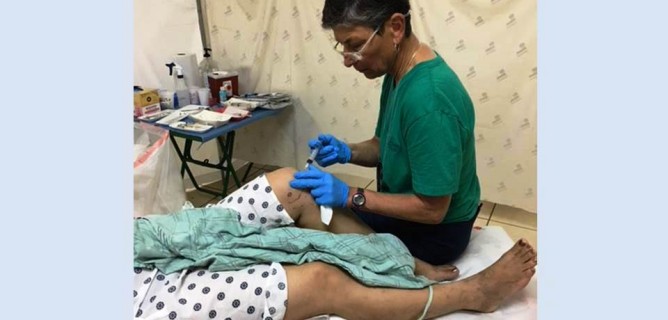By Annette “Dr. Z” Zaharoff, M.D.
We all know the feeling of stepping on a thorn, or getting a paper cut.
What happens next is fascinating in many ways. Microscopic pain receptors, or nociceptors, in the skin are activated by tissue damage. Each pain receptor forms one end of a nerve cell (neuron). It is connected by a long nerve fiber or axon to the other end lying in the spinal cord. Pain signals travel along the spinal cord to the brain.
For a pin prick, pain is usually a passing sensation. But consider the causes of chronic nerve pain – arthritis, repetitive stress, and occupational, surgical and sports injuries. This kind of pain more than lingers; it persists and can be debilitating in certain circumstances.
I recently returned from my annual trip to the University of Wisconsin-Madison to help lead the Prolotherapy Symposium, helping clinicians from around the world learn more about this non-surgical treatment for orthopedic injuries. I soon will be treating people in my clinic using a technique that was among the featured topics at this year’s conference – perineural injections.
I’ve been studying perineural injections for some time now. This form of treatment utilizes the basic principles of Prolotherapy, which uses the combination of a solution of dextrose (the body’s own naturally produced sugars) and lidocaine, being injected into damaged tissue or joint space to initiate what I like to call the healing cascade.
The difference is that most Prolotherapy injections use something along the lines of a 15 percent solution of dextrose. With perineural injections, the dextrose concentration is only about 5 percent. Also, instead of injecting deep into damaged tendons or muscle tissue, the injections are done just under the surface of the skin to treat neural pain receptors. The target sites are the “subcutaneous” nerves.
It can be used to treat all sorts of pain – headaches, sciatica, arthritis, tendinitis, sports injuries and more. Perineural injections can inhibit the pain pathway, and make the pain go away.
There is good evidence behind this. In August 2017, the Mayo Clinic published a study titled “Six-month Efficacy of Perineural Dextrose for Carpal Tunnel Syndrome.” This prospective, randomized, double-blind controlled trial examined the efficacy of ultrasound-guided perineural injection therapy of a 5 percent dextrose solution in patients with mild-to-moderate carpal tunnel syndrome (CTS). The control group received just saline injections.
The results were that compared to the control group, the group receiving dextrose injections “had a significant reduction in pain and disability, improvement on electrophysiological response measures, and decreased cross-sectional area of the median nerve.”
“Our study reveals that ultrasound-guided PIT with D5W (5 percent dextrose solution) is an effective treatment for patients with mild-to-moderate CTS.”
Along with pain relief, perineural injections offer real healing. Patients and clinicians utilizing this treatment report that with more frequent treatments, usually weekly, pain levels diminish and pain relief lasts longer. Patient have reported achieving a “zero” pain score in six to eight sessions
The reason is fairly logical: Perineural injections help the body to change nerve signals, blocking pain and stimulating the body’s natural ability to heal. I am very excited to begin offering this treatment to patients who are good candidates to benefit from it.
Every year, we learn more and more about how Prolotherapy can be utilized more and more effectively to treat orthopedic pain. I look forward to what the new year will bring.
Dr. Annette “Dr. Z” Zaharoff heads the Non-Surgical Center of Texas, focusing on non-surgical treatments to relieve pain and repair injuries. A former professional tennis player who competed on the WTA circuit, Dr. Zaharoff has been utilizing regenerative injection treatments including Stem Cell Therapy, PRP Injection Therapy and Prolotherapy for more than a decade. Learn more about her at www.drzmd.com. You can follow her on Facebook at www.Facebook.com/DrZaharoff.

